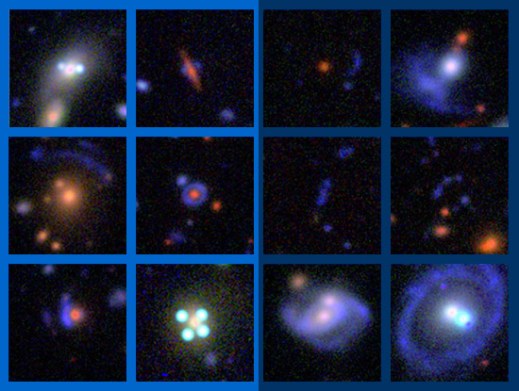Using Space Warps to Discover and Weigh Galaxies

John Wheeler once summarized General Relativity as “Matter tells space how to curve, and space tells matter how to move.” While that is a handy description, and while there have been many textbooks written, lectures given and websites constructed to explain this, the quote itself doesn’t address what happens to the light streaming through the universe as it encounters the warped space curved by matter.
 The simple answer is: it curves too, and Einstein’s equations provide predictions for exactly how it works. In fact, observations of the bending of starlight around the Sun were one of the first implemented tests of General Relativity, and it passed with flying colors. On the scale of the Universe, the Sun isn’t that massive, but it’s massive enough to bend the light just a little, and by exactly the amount the equations predicted.
The simple answer is: it curves too, and Einstein’s equations provide predictions for exactly how it works. In fact, observations of the bending of starlight around the Sun were one of the first implemented tests of General Relativity, and it passed with flying colors. On the scale of the Universe, the Sun isn’t that massive, but it’s massive enough to bend the light just a little, and by exactly the amount the equations predicted.
Those equations say that more matter in the same place is more likely to produce a strong lens effect, distorting and magnifying a background source. So what happens when you have a *lot* of matter, say, in a big galaxy or a cluster of galaxies?

From left to right: a) an Einstein cross (credit: NASA/ESA); b) an example from the Space Warps dataset; c) a known lens in CANDELS that Galaxy Zoo users spotted.
Some pretty impressive configurations, which are rare but which humans are best at finding — hence Space Warps, the Zooniverse’s newest project and our astronomical project sibling. Co-lens-experts Phil Marshall and Aprajita Verma joined us during this hangout to describe how they use gravitational lenses to weigh galaxies. In particular, they can tell the difference between Dark Matter and “matter that’s dark” — the former being the exotic particles that are very different from stars and gas and planets and people, and the latter being normal matter that isn’t bright, such as brown dwarf “stars” that never actually ignited.
Note: Google+ was feeling a bit out of sorts, so the first minute or so of the broadcast was cut off, during which time Bill Keel showed us the first known image of a gravitational lens, from 1903. We went on to talk about all of the above, and more besides, including the importance of simulated lenses, why the images Space Warps uses are specially tuned to help us find lenses, and how the science team (which includes citizen scientists from Galaxy Zoo!) plan to turn our clicks into discoveries.
(or download the podcast mp3 here)
Notice my swapping of pronouns to “we” — I’m not on the Space Warps science team, but I’ve done nearly 100 classifications now myself! I can’t wait to see the results start to come in from this project.
